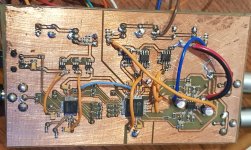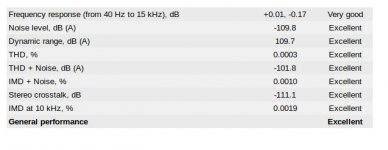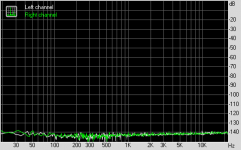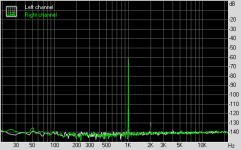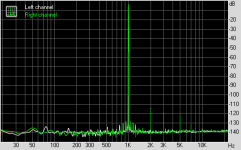This site has a lot of useful information about how to get close to the datasheet specs from the lm3886 which also includes a section about grounding.
Taming the LM3886 Chip Amplifier
I think the biggest pitfall in chipamp/DIY audio design and the most important thing in any power audio amplifier is the grounding, especially the location of signal grounding. Incorrect signal grounding can lead to dramatically increased THD and increased error voltages across the load.
Wow, thanks for bringing that to our attention, even after it was referenced 4 times previously in the thread.
Not that i neleive THD has any merit when it comes to sonics, check out the measured distortion on Tom C’s 3886 based amps (the last ones i have heard are excellent.
Execution is critical.
dave
Execution is important, but Tom's designs, which is a composite lm3886 amp (2 additional opamp's, 3 if you include the THAT input stage) are very complex, technically demanding design's. Maintaining stability is challenging and only a audio professional with advanced design knowledge, measuring equipment and PCB design knowledge can pull it off and get such a result and maintain stability. I guess even with his genius, he had to compromise on the bandwith to improve stability and to maintain the low THD, the measurement of the modulus 286 at audioscience showed a early -0.4dB drop at 20Khz.
The LM3886 is a good (if not the best) class B chipamp and is the last of its kind as the market for class B chipamp's is almost non-existent with the rapid advancement of Class D chipamp design's which give manufacturers the same performance with far lesser heatsink and power requirements due to improved efficiency. It's a tribute to it that its lasted this long, but its a niche part, and the writing is on the wall and we should expect a announcement from TI soon saying its going to EOL the lm3886.
Wow, thanks for bringing that to our attention, even after it was referenced 4 times previously in the thread.
Your sarcasm is noted, but still the truth is that IMHO it is the most important resource on the net not only for the lm3886 but for any power amplifier design. Its written by a professional with years of experience of analog design and not someone tinkering with a lm3886 in their mothers basement. Also I wanted to make the point that the signal grounding is a very important part of amplifier design which most DIY'er designs get wrong. Professional's like Tom (the authour of the site) never return the signal ground to the star ground, but return it to the load ground.
Your sarcasm is noted, but still the truth is that IMHO it is the most important resource on the net not only for the lm3886 but for any power amplifier design. Its written by a professional with years of experience of analog design and not someone tinkering with a lm3886 in their mothers basement. Also I wanted to make the point that the signal grounding is a very important part of amplifier design which most DIY'er designs get wrong. Professional's like Tom (the authour of the site) never return the signal ground to the star ground, but return it to the load ground.
So I guess you still haven't figured out that he posted post #6?
Guys Guys Guys
But no real info of how to get the best possible performance out of chip amps including the LM3886 of course and how to avoid the many pitfalls there are.
Cheers Michael
A few things which i have used in the past which i hope helps.
1. start off with a good circuit layout. The LM1875 datasheet has a excellent typical application circuit. For the feedback i use 22K and 680 ohms which was used in the original gaincard amplifier by Kimura san which started all this craze.
2. Consider using the insulated LM3886TF, slight trade off as heat transfer is less than the LM3886, but you save on the insulated mounting equipment and trouble which you might go to otherwise when mounting the uninsulated part. Avoid the TF insulated variant if your speakers are 4 ohms.
3. PCB design - Use the basic star ground scheme, but return the signal ground to the load ground and then to the star ground.
4. Choose the correct transformer (I use 25-0-25 for 8ohm loads). TI has a spreadsheet calculator where you can check the power supply voltage versus heatsink requirements for safety. The IC has excellent PSRR so a unregulated supply can be used.
5. Mounting the NF resistor (22k) on top of the pins it: It makes theoretical sense to reduce inductance, but its not a easy thing to do quickly. Objective measurements are needed to decide if mounting it on the pins versus the PCB has any significant effect.
7. To use the output zobel and thiele networks. Quite a lot of DIY designs discard these networks and get away with it as the 3886 is a stable chip and can be abused a lot. But it is strongly recommended to use the output networks to avoid oscillation and frying the tweeters.
Ultimately you will need to buy or loan high quality measuring equipment like the dScope or APx - these are expensive but without them there is no way you will know reliably that you have got the "best possible" performance out of the amp.
The following site should be useful, it shows the circuit of the gaincard, this is a good starting point and it was the amp which started the whole thing and had rave reviews and excellent measurements on stereophille.
RJM Audio - LM3875 Non-inverting Gainclone
... the speakers are the weakest link...
While a speaker, even the best, is the lagard performance-wize, the kind of mistakes an amplifier makes can be detected at much smaller levels than those in a speaker.
There is certainly a significant difference between the Neurochrome 3886, the ACA, and the SIT3 i have used recently. They all do a decent job, but each has its own strengths which can easiy be discerned despit the speaker in between them and my (our) ears.
I also have a Class A triode EL84 PP and an Audio Sector 3875 amp that perform well.\, but each different in its own way.
dave
dave
A few things which i have used in the past which i hope helps.
1. start off with a good circuit layout. The LM1875 datasheet has a excellent typical application circuit. For the feedback i use 22K and 680 ohms which was used in the original gaincard amplifier by Kimura san which started all this craze.
2. Consider using the insulated LM3886TF, slight trade off as heat transfer is less than the LM3886, but you save on the insulated mounting equipment and trouble which you might go to otherwise when mounting the uninsulated part. Avoid the TF insulated variant if your speakers are 4 ohms.
3. PCB design - Use the basic star ground scheme, but return the signal ground to the load ground and then to the star ground.
4. Choose the correct transformer (I use 25-0-25 for 8ohm loads). TI has a spreadsheet calculator where you can check the power supply voltage versus heatsink requirements for safety. The IC has excellent PSRR so a unregulated supply can be used.
5. Mounting the NF resistor (22k) on top of the pins it: It makes theoretical sense to reduce inductance, but its not a easy thing to do quickly. Objective measurements are needed to decide if mounting it on the pins versus the PCB has any significant effect.
7. To use the output zobel and thiele networks. Quite a lot of DIY designs discard these networks and get away with it as the 3886 is a stable chip and can be abused a lot. But it is strongly recommended to use the output networks to avoid oscillation and frying the tweeters.
Ultimately you will need to buy or loan high quality measuring equipment like the dScope or APx - these are expensive but without them there is no way you will know reliably that you have got the "best possible" performance out of the amp.
The following site should be useful, it shows the circuit of the gaincard, this is a good starting point and it was the amp which started the whole thing and had rave reviews and excellent measurements on stereophille.
RJM Audio - LM3875 Non-inverting Gainclone
You might want to talk to Grendel321 who posted earlier in the thread, he's got nothing good to say about chipamps.
You might want to talk to Grendel321 who posted earlier in the thread, he's got nothing good to say about chipamps.
Brother, i fail to see what i have done to offend you. If i speak different it's because I am from africa and learn to write english from the textbook. I know i don't have a degree in electronics unlike most other people in this respected forum, because i did not have a connection to the minister to be selected for study. So i have worked in the quarry for most of my life, but i thought myself to read, and study electronics theory and then started my second job repairing electronic items at night after work for many years.
I also design DAC's and amplifier's for the church. For example our father Matthew wanted a DAC so I have designed a AK4497 DAC which measures reasonably for a prototype single sided PCB. I share some pictures and measurements. Father Matthew approved the sound quality but tells me to further improve it. So I plan to design and create a 4 layer PCB and verify its performance with the dScope and once the father approves to then release all the source code to the community so that anyone can do whatever they want with it. I got attacked by a wild boar recently so i have put that project on hold for the moment.
I tell my brothers of the forum that not to think bad because i dont have a formal electronics education and appear unrefined, but to understand that i want to learn and contribute.
Attachments
Now we seem to start to get somewhere at last. While it seems true that Grendel321 does not have much good to say about chp-amps the information in his last post in itself is correct as far as I can see.
Please let all of us try to stay objective here and avoid letting this thread turn into a heated emotional discussion.
What we are dealing with here is the chip-amps and how to make the best of and with them. Wether ultimately the chip-amps are a holy grail or the devils work is not really the point is it now ??
Here I want to say something which Tom often has said and repeated :
Let us stay objective and as scientific as we can . Let us stay with proven facts that can be measured and demonstrated. we are discussing chip-amps and not chip-amps versus God or Satan.
Cheers Michael
It seems to me that the digital amps may well end up killing the traditional chip-amps and that again is not a question of Heaven or Hell . But it sure is or rather will be a big shame. We should be aware of the fact.
Please let all of us try to stay objective here and avoid letting this thread turn into a heated emotional discussion.
What we are dealing with here is the chip-amps and how to make the best of and with them. Wether ultimately the chip-amps are a holy grail or the devils work is not really the point is it now ??
Here I want to say something which Tom often has said and repeated :
Let us stay objective and as scientific as we can . Let us stay with proven facts that can be measured and demonstrated. we are discussing chip-amps and not chip-amps versus God or Satan.
Cheers Michael
It seems to me that the digital amps may well end up killing the traditional chip-amps and that again is not a question of Heaven or Hell . But it sure is or rather will be a big shame. We should be aware of the fact.
Last edited:
Except its not class b amplifier. He got that wrong.
Other thing he got wrong is that sound quality correlates with distortion. It does not.
I got technics amp with 0.0007% distortion and it sounds boring. I got el84 amp reaching 1% distortion which sounds way better. I got three ACA (up to 1% distortion, yet sweet sounding), F4, F5, M2, goldmund clones, more then dozen of chip amps, even excellent sounding current source circuits, yet there is no correlation between the sound quality and distortion.
Check out transconductance lm3886 circuits, completely different animal.
Other thing he got wrong is that sound quality correlates with distortion. It does not.
I got technics amp with 0.0007% distortion and it sounds boring. I got el84 amp reaching 1% distortion which sounds way better. I got three ACA (up to 1% distortion, yet sweet sounding), F4, F5, M2, goldmund clones, more then dozen of chip amps, even excellent sounding current source circuits, yet there is no correlation between the sound quality and distortion.
Check out transconductance lm3886 circuits, completely different animal.
Please realize that the distortion parameter 0.0003% is meaningless, because it is taken from full power just before clipping. At lower levels, at which we actually listen, it is much higher and steadily increasing towards zero.
Opposite to single ended class a amp, which may have high distortion at full power, but the distortion steadily decreases towards zero.
Hence big difference in sound quality.
Opposite to single ended class a amp, which may have high distortion at full power, but the distortion steadily decreases towards zero.
Hence big difference in sound quality.
excerpt from BPA300 GC - 300W 6x LM3886 bridged-paralleled power amplifier from Shine7...
One of the PA150 is connected to the speaker's positive input, and the other PA150 is connected to the speaker's negative input. Because of this push-pull configuration, the total gain of the amplifier is doubled. Each PA150 has a gain of 20, so the gain of the BPA300 is 40.
One of the PA150 is connected to the speaker's positive input, and the other PA150 is connected to the speaker's negative input. Because of this push-pull configuration, the total gain of the amplifier is doubled. Each PA150 has a gain of 20, so the gain of the BPA300 is 40.
Other thing he got wrong is that sound quality correlates with distortion. It does not.
I got technics amp with 0.0007% distortion and it sounds boring. I got el84 amp reaching 1% distortion which sounds way better. I got three ACA (up to 1% distortion, yet sweet sounding), F4, F5, M2, goldmund clones, more then dozen of chip amps, even excellent sounding current source circuits, yet there is no correlation between the sound quality and distortion.
I never said that sound quality correlates only with distortion. THD is meaningless without referencing the frequency. A amp which has 0.001% THD at 1khz and a poor 1 % THD at 20khz would definitely sound not good. Also a amp with a second harmonic distortion of 1% would sound better than one with a 3rd harmonic distortion of 0.1%.
"Sound quality" is a subjective term, but if you are looking for a amp which would try to be as true to the input source as possible ie: accuracy, then the important parameters would be clear: Flat frequency response within the audio band, low THD 1khz and low THD at 20khz, low IMD, very low output noise, high SNR and dynamic range, low crosstalk, and exceptional linearity. Any amplifier designed accordingly will receive rave reviews, the Benchmark AHB2 is one example which has near universal acclaim amongst the golden ear reviewers.
Ultimately it's upto each individual to choose what their priority is in a amplifier. Anyone is free to choose between a accurate amplifier and a amplifier which adds color (Second harmonics). I have no doubt both will sound great, the human ear and brain work in mysterious ways.
- Status
- This old topic is closed. If you want to reopen this topic, contact a moderator using the "Report Post" button.
- Home
- Amplifiers
- Chip Amps
- LM3886 (and other chipamps too)
